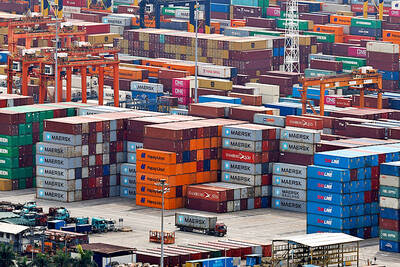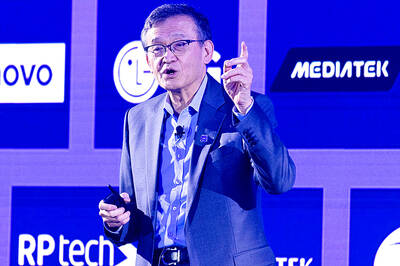Japan's five top makers of flat screen displays said yesterday they are investing heavily to increase domestic production in response to growing global demand for the latest in television and computer displays.
Sharp Corp, Fujitsu Ltd, Hitachi Ltd, Matsushita Electric Industrial Co Ltd and NEC Corp are pumping money into new factory lines to boost production capacity of liquid crystal display (LCD) monitors and plasma display panels (PDPs).
The global market for LCD televisions is expected to hit 1.5 million units this financial year to March, of which Sharp -- the world leader in this field -- aims to control two thirds.
The firm will also double its investment in LCD production to Japanese Yen 108 billion (US$915 million) in the year to March 2004, hoping to increase sales of its flat screen television sets, spokesman Testuya Iganashi said.
Fujitsu Hitachi Plasma Display, a 50-50 joint venture between the two technology giants, is spending around Japanese Yen 10 billion to lift plasma display production capacity by 50 percent to around 50,000 units a year by summer, a spokesperson said.
Plasma displays are used in products such as large flat screen televisions, whereas LCD panels are more suited to smaller TVs as well as the monitors in notepads and personal computers, explained the spokesperson from Fujitsu.
"I think there has been a pick up in demand [for plasma displays] with digital televisions coming," he said. "The production volume has been increasing and prices are coming down, which makes it more attractive for the customer, the overall momentum of the market is increasing."
Domestic demand is booming, and products from the joint venture were also doing well in Europe and the US, the spokesman said, adding that the joint venture company was the market leader in plasma display panels.
Hitachi said it was also increasing LCD production under a plan initially unveiled last year, which would see production capacity double at a plant in Chiba, just east of Tokyo, during the first quarter of 2003.
"Hitachi would like to produce LCD TV panels and we need to increase capacity as the LCD market is getting bigger ... We want to get a good position in that market," spokesman Yoshiaki Segawa said.
The firm launched a new LCD television last month and hopes this will help fuel sales growth.
Matsushita Plasma Display Production Co, a joint venture between Matsushita Electric and Toray Industries Inc, would invest Japanese Yen 60 billion to build a new plant in Japan, a spokeswoman said.
The firm's monthly production capacity at the end of March 2004 is targeted at 65,000 screens, triple that of this financial year.
"We aim to control 30 percent of the global PDP market by 2005, becoming the world number one," the spokeswoman for Matsushita Electric, Yoko Fukusaki said.
NEC was also determined not to be left behind in the rush to boost flat screen display production. The technology titan has been investing Japanese Yen 27 billion in a plant in Kagoshima, 960km southwest of Tokyo, to treble production by the end of March.
"The PDP market has grown quickly with all major TV manufactures successively injecting new products into the market," an NEC spokesman said.

The Eurovision Song Contest has seen a surge in punter interest at the bookmakers, becoming a major betting event, experts said ahead of last night’s giant glamfest in Basel. “Eurovision has quietly become one of the biggest betting events of the year,” said Tomi Huttunen, senior manager of the Online Computer Finland (OCS) betting and casino platform. Betting sites have long been used to gauge which way voters might be leaning ahead of the world’s biggest televised live music event. However, bookmakers highlight a huge increase in engagement in recent years — and this year in particular. “We’ve already passed 2023’s total activity and

Nvidia Corp CEO Jensen Huang (黃仁勳) today announced that his company has selected "Beitou Shilin" in Taipei for its new Taiwan office, called Nvidia Constellation, putting an end to months of speculation. Industry sources have said that the tech giant has been eyeing the Beitou Shilin Science Park as the site of its new overseas headquarters, and speculated that the new headquarters would be built on two plots of land designated as "T17" and "T18," which span 3.89 hectares in the park. "I think it's time for us to reveal one of the largest products we've ever built," Huang said near the

China yesterday announced anti-dumping duties as high as 74.9 percent on imports of polyoxymethylene (POM) copolymers, a type of engineering plastic, from Taiwan, the US, the EU and Japan. The Chinese Ministry of Commerce’s findings conclude a probe launched in May last year, shortly after the US sharply increased tariffs on Chinese electric vehicles, computer chips and other imports. POM copolymers can partially replace metals such as copper and zinc, and have various applications, including in auto parts, electronics and medical equipment, the Chinese ministry has said. In January, it said initial investigations had determined that dumping was taking place, and implemented preliminary

Intel Corp yesterday reinforced its determination to strengthen its partnerships with Taiwan’s ecosystem partners including original-electronic-manufacturing (OEM) companies such as Hon Hai Precision Industry Co (鴻海精密) and chipmaker United Microelectronics Corp (UMC, 聯電). “Tonight marks a new beginning. We renew our new partnership with Taiwan ecosystem,” Intel new chief executive officer Tan Lip-bu (陳立武) said at a dinner with representatives from the company’s local partners, celebrating the 40th anniversary of the US chip giant’s presence in Taiwan. Tan took the reins at Intel six weeks ago aiming to reform the chipmaker and revive its past glory. This is the first time Tan